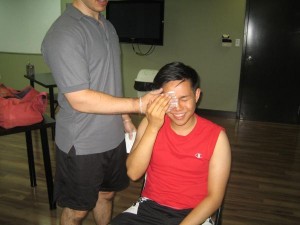Subconjunctival hemorrhage pertains to blood found between the sclera and the conjunctiva. The sclera is the white surface of the eyeball, whereas the conjunctiva is the clear tissue that protects the sclera and the inner folds of the eyelids from external environment. The conjunctiva contains numerous blood vessels and nerves. Although small, the blood vessels can be slightly seen by the naked eye, especially when the eye is inflamed as the blood vessels increase in size. Because the blood vessels are slightly fragile, the walls of the blood vessels break easily resulting to bleeding under the conjunctiva.
Subconjunctival hemorrhage may be confused with hyphema which is blood in the front area of the eye, between the cornea and the iris. The former is usually painless to mildly painful whereas the latter is characterized by eye pain. Subconjunctival hemorrhage is usually harmless and does not pose serious long-term complications. They do not usually require medical treatment.
Causes of Subconjunctival Hemorrhage
Majority of the cases of subconjunctival hemorrhage are spontaneous with no apparent cause for the rupture of blood vessels. The following are possible causes of spontaneous subconjunctival hemorrhage:
- Hard coughing and sneezing
- Straining or vomiting
- Forceful eye rubbing
- Accumulating pressure in the veins of the head, such as in heavy lifting
- Contact lenses
- Constipation
- Eye infection such as, conjunctivitis (bacterial, viral, allergic, etc.)
- Medical disorder that involved bleeding or hinders clotting of bleeding such as leukemia and sickle cell disease
- Other medical conditions such as diabetes and hypertension
The following are non-spontaneous causes of subconjunctival hemorrhage, which include:
- Head or eye trauma
- Severe eye infection
Signs and Symptoms of Subconjunctival Hemorrhage
Since subconjunctival hemorrhages are usually painful, bleeding in the eyemay only be noticed when another points it out or when one checks the mirror. Generally, no symptoms occur with subconjunctival hemorrhage. However, there are rare cases where several signs and symptoms of subconjunctival hemorrhage may appear.
- Bright red or dark patch of blood on the sclera that will not exit from the eye
- Usually painless, though some may be mildly painful
- Sensation that there is something in the eye
First Aid Treatment and Management for Subconjunctival Hemorrhage
It is necessary to visit an eye doctor (ophthalmologist) or a physician to examine the

subconjunctival hemorrhage to be sure that there is no danger involved. However, while a visit to an eye doctor may take days. Subconjunctival hemorrhage will usually disappear within days to weeks, without medical treatment. First aid treatment can be applied to reduce discomfort.
- Apply over-the-counter (OTC) artificial tears if mild irritation or scratchy feeling is present. There is no need to wear an eye patch.
- Do not use aspirin or other clotting medications.
- If it is caused by trauma, treat accordingly. Ask the doctor before taking medications.
Disclaimer: The following information should not be used for medical advice or treatment. To learn more about subconjunctival hemorrhage and other eye conditions, enroll in First Aid Training to be educated on proper treatment and management.
